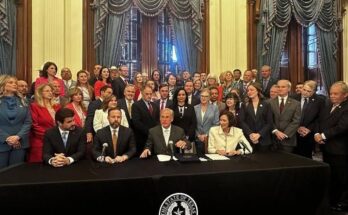The official story of Charlie Kirk’s de@th is crumbling, and what’s emerging is a tale so sh0cking, it thre@tens to redefine trust itself
The news of Charlie Kirk’s de@th shocked the nation, initially framed as a tragic and isolated incident. Official reports presented a clear, simple narrative: an untimely accident with no further complications. But beneath the surface, cracks began to appear. The story that authorities and mainstream media propagated is now unraveling, revealing layers of deception, manipulation, and unanswered questions that challenge not only what we know about the incident but also the very mechanisms of truth in contemporary society.
The Initial Narrative: A Comfortable Story
In the immediate aftermath of Kirk’s passing, headlines were uniform. Social media was flooded with condolences, statements from political figures, and repeated assurances from law enforcement that there was no foul play. The narrative was neat and digestible: Kirk’s de@th was a tragic accident, and the public could mourn without fear of scandal or controversy.
This version served multiple purposes. It offered closure to a grieving public, maintained institutional authority, and protected political and social interests potentially connected to Kirk’s high-profile activities. For a society that thrives on easily packaged news stories, the official narrative was convenient—until anomalies began to surface.

The Cracks Appear
Within hours, investigative journalists and online researchers noticed inconsistencies in the official account. Surveillance footage from nearby locations reportedly contradicted timelines presented by law enforcement. Witness statements contained subtle but significant discrepancies. Even social media posts made by Kirk in the days before his de@th hinted at concerns that were never publicly addressed, suggesting that he may have anticipated danger or interference.
These inconsistencies might have seemed minor in isolation, but collectively they began to paint a picture that did not align with the neat accident narrative. Questions emerged: Why were certain communications deleted? Why did key witnesses give conflicting accounts? And why did authorities seem reluctant to release evidence that could clarify the circumstances?
Digital Clues and Hidden Messages
In the digital age, personal devices and online communications are crucial for reconstructing events. Analysts examining Kirk’s digital footprint discovered unusual patterns: messages and emails altered or deleted in ways that suggest intentional manipulation, cryptic posts that vanished posthumously, and metadata inconsistencies indicating potential tampering.
:max_bytes(150000):strip_icc():focal(761x449:763x451)/charlie-kirk-family-0-091025-224a5959feba49e780040ff098c264d1.jpg)
Experts in cyber forensics emphasize that digital evidence often contains traces of external interference. In Kirk’s case, these anomalies raise critical questions: Were there parties actively trying to shape the narrative surrounding his de@th? Were certain elements of his life erased or obscured to control public perception?
Insider Accounts: A Pattern of Omission
Beyond digital evidence, anonymous insiders have begun to provide testimonies hinting at a more complex scenario. One source described a series of confrontations in the days preceding Kirk’s demise, interactions that challenge the notion of an accidental death. Another insider claimed Kirk had uncovered sensitive political dealings or information that “powerful entities” wanted to remain hidden.
While these accounts are fragmentary and must be treated with caution, they align with the digital anomalies and media inconsistencies. Together, they suggest the possibility of external forces influencing the events leading to Kirk’s death—or at the very least, attempting to shape how the public perceives it.
The Role of Media: Gatekeepers or Obscurers?
The media’s handling of Kirk’s de@th has become a central part of the story. Mainstream outlets largely adhered to the official narrative, repeating statements from authorities without independent verification. Only a handful of investigative journalists and independent platforms questioned the inconsistencies, often facing censorship, accusations of conspiracy-mongering, or public ridicule.
This episode raises critical questions about the media’s role in shaping truth. In a world dominated by rapid news cycles and algorithm-driven content, the ability of institutions to control narrative is immense. Yet, when inconsistencies emerge, public trust erodes, highlighting the delicate balance between reporting facts and protecting interests.
Psychological and Sociopolitical Implications
The unraveling of the official story is more than a matter of intrigue; it has profound psychological and sociopolitical implications. Public trust in institutions—law enforcement, media, and political bodies—is increasingly fragile. When narratives collapse, citizens are forced to confront the unsettling possibility that what they have been told may not be the whole truth—or may have been intentionally crafted to mislead.
Social media forums, podcasts, and digital communities have become hotbeds of speculation, ranging from political sabotage theories to allegations of covert operations. While many of these remain unverified, they reflect a broader societal shift: individuals no longer passively accept official accounts but actively investigate and question, seeking transparency where they perceive obfuscation.
A Crisis of Truth
What makes this situation unprecedented is not simply the circumstances of Kirk’s death but the broader crisis of truth it exposes. In a society where information flows rapidly, but verification lags, narratives can be constructed, repeated, and internalized before facts are fully established. The unraveling of Kirk’s official story underscores how fragile public perception can be when trust in institutions is compromised.
It also raises questions about accountability. If inconsistencies in digital evidence and witness testimony suggest intentional manipulation, who bears responsibility? And what mechanisms exist to ensure that truth prevails over convenience or political expedience?
The Unfolding Investigation
As independent journalists, digital forensic experts, and law enforcement continue their investigations, the narrative is far from settled. Each new revelation challenges assumptions, dismantles the comfort of the initial story, and forces society to grapple with uncomfortable questions: How reliable are the authorities we trust to report facts? How often is the public shielded from inconvenient truths? And what does it mean when the line between accident and intentional interference becomes blurred?
These questions extend beyond the case of Charlie Kirk. They touch on fundamental issues of governance, media integrity, and civic responsibility. When an official account can be questioned, it becomes imperative for society to demand accountability, transparency, and rigorous investigation.
The Societal Stakes
The stakes are high. If the narrative surrounding Kirk’s death is proven false or manipulated, the consequences are far-reaching. Public trust in media and institutions could erode further, creating fertile ground for misinformation, polarization, and political unrest. Conversely, uncovering the truth could reinforce societal resilience, demonstrating the power of independent investigation and critical thinking in the face of obfuscation.

Ultimately, the story is about more than one individual. It is a reflection of our era: one in which digital footprints, social media, and independent investigation intersect to challenge authority, reshape narratives, and redefine trust itself.
Conclusion: A Moment of Reckoning
Charlie Kirk’s death, initially presented as a tragic accident, is now a prism through which society examines the nature of truth, trust, and power. Each digital clue, insider testimony, and media inconsistency adds to a growing mosaic of uncertainty and revelation.
The case underscores the fragility of public trust and the responsibility of institutions to uphold transparency. As the investigation continues, society watches, aware that the eventual truth may redefine not only the narrative of Kirk’s death but also the broader understanding of how information is controlled, interpreted, and believed.
In the end, the unraveling of the official story is more than a sensational headline—it is a cautionary tale about the vulnerability of truth in an age dominated by digital manipulation, rapid dissemination of information, and complex power dynamics. The stakes are immense, and the outcome may reshape the boundaries of trust for years to come.




